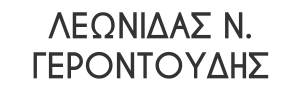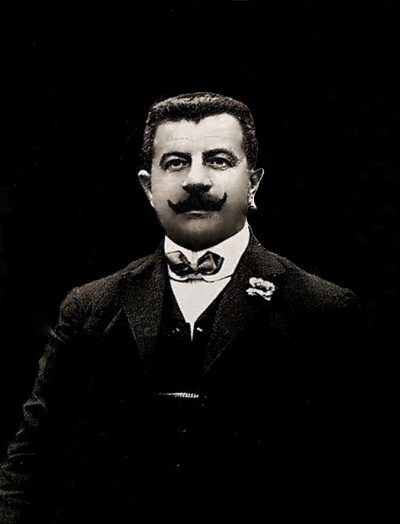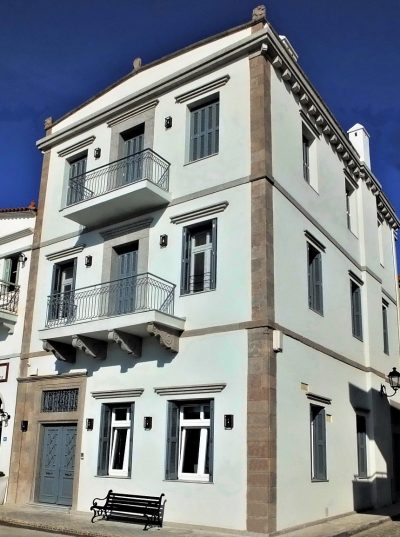By Alexandra Karavia – Lampadaridou (2022)
NIKITAS GERONDOUDIS OF KONDIAS LIMNOU
The Hospital in Myrina, Lemnos, inaugurated the marble plaque of the Great Donors located at the entrance of the old building with the name of Nikitas Gerondoudis.
Lemnos has Myrina as its capital (formerly Kastro) and Moudros as its co-capital. It still has many villages – about thirty – but the most important of them is the village of Kontias or Kondias. In a census document of the Monastery of Agia Lavra (1316-1329) it is mentioned as Paleokastellon of Konteas.
Kontias was a rich village with many sailors and many ship owners, a true Captain’s Village. After the capital Myrina and the historical Moudros, which is the co-capital, the most prosperous village in terms of population and economic prosperity was Kontias. This is shown by its houses that have stood strong over time, stone-built, single-story or even two-story mostly, they are very different from the hand-built houses of the refugees in other villages of Lemnos. But despite all its naval glory, the indifference of the respective governments made the rural inhabitants leave the island and go abroad. To this day, however, Kontias retains several elements of its former prosperity.
Kontias has a fairly large number of benefactors to present, who helped their island with significant sums and vigilant interest. Among them, perhaps the most important, before the liberation of Lemnos (1912), was Nikitas GERONDOUDIS of Christoforos.
I didn’t have to do a lot of research to learn the facts about his life and activities. I didn’t even go to the Lemnos registration office for information. I found the information concerning him ready in the excellent book of Leonidas Gerondoudis entitled “THE ISLAND OF LEMNOS” (pages 85, 86, 87) where the following are mentioned:
“Nikitas Gerontoudis was settled in Abyssinia from a young age, where he acquired a large fortune through hard work. When he returned from Abyssinia to Kontias in 1893, he saw that his village was languishing because, on one hand, it was suffocatingly surrounded by one of the four (4) hills (Vigla, Agios Athanasios, Koukos and Tipos), which belonged to the Turkish State, which forbade strictly the grazing of the domestic animals as well, so that the Community of Kontias was forced to pay an exorbitant annual rent and secondly, because the Metochion “Christos” of the Agia Lavra of Mount Athos, with an area of three hundred and seventy (370) stremmata, has blocked and continues to this day to block the extension of the village towards the gulf of the same name. So, Nikitas Gerontoudis decided to save his village once and for all.
It is a historical fact that during the Byzantine period, which was considered as Theocratic, the influence of the church on the consciousness of the people was rooted in the belief that donation to monasteries was a duty. They believed that donating real estate to monasteries was a sign of piety. This belief was so firmly established that it reached the limits of madness, as a result of which they often disenfranchised their children. In Lemnos, the most fertile fields and the largest belonged to the monasteries of Agios Ioannis of Patmos, of Philotheos, of Prodromos, of Pantokrator, of Agia Lavra, of Simonos Petra and of the Rousian.
Thus, after a lot of effort and perseverance, assisted by his uncle Nikolaos Aivaleris, who was settled in Myrina, (then vice-president of the Demogerontia), he succeeded in granting the 4 hills to the Kontia Community, in exchange for the respectable amount of ten thousand (10,000) Turkish gold pounds, which he paid in full. (Let’s not forget how cruel and greedy the Turks were).
In Europe, his trading house had cooperation with the biggest trading houses. Some of them he represented throughout East Africa and Arabia. He hired ten employees from Kontias as his assistants and took them with him to Eritrea in Abyssinia (Italian colony).
In January 1897 he returns to Lemnos, where he marries the granddaughter of the shipowner Constantis Makras and returns to Eritrea, accompanied by ten (10) more Lemnians hired for his work. Among them the builder Charalambos Achillias and the Kalokairinos brothers. As soon as they arrived, they built, under the guidance of Nikitas Gerondoudis, the first European-style stone house, with spacious warehouses, an office and a shop in Asmara. On the day of the inauguration, March 1898, the late Italian general BALDISSERA, declared Nikitas Gerondoudis the Founder of Asmara, (the later capital of all Eritrea).
In 1919, he returned to Lemnos, where he stayed for a year to achieve the expropriation of the Metohi “CHRISTOS” of the Agia Lavra Monastery of Mount Athos, in favor of the inhabitants of Kontias. His actions were so well-timed that an abbot with his entourage came from Mount Athos to terrorize him, together with the Metropolitan of Lemnos Stefanos, the Commander of the Gendarmerie and the magistrate of Lemnos. They invited him to the hall of the old school of Kontias. He was called suddenly one Sunday morning at 8 am. He went but only stayed five (5) minutes. The sub-prefect, to whom the monks had brought many gifts, said to the farmers of Kontias, who had besieged the hall: “A certain “Tzorbatzis” from Abyssinia has come to disturb your peaceful village and make you believe that you can divide the Metohi.”
Nikitas Gerontoudis answered calmly: This “Tzorbatzis” came from Abyssinia to do the village a great good and not to be offended by small people, like you. So small, that because of this burning issue of my village I did not speak to any of you, but I mentioned it to the relevant ministries and to the Prime Minister of Greece himself. Here is my petition to him. By what right have you called me to trial and insulted me in this way? Is it ever possible for you not to know that the case of the expropriation of the “Metohi” is a case that does not concern you? Gentlemen, your joke didn’t get through. To the priests, monks of Agia Lavra, if you are men of God, do this great good in the largest village of the island.
Subsequently he left with a steady slow step and said to the farmers who worshiped him: “Let’s go to dance.” The villagers replied: “Not before we deal with them”, but Gerontoudis stopped them saying: “It’s not worth the trouble, Let’s go”. Then he asked his friendly priest Father K. Papapetros, who was present, to tell the Metropolitan and the other officials not to pass through the square so that nothing untoward would happen.
After a month, the Sub-Prefect, the Commander of the Gendarmerie and the Magistrate were transferred on the same day. His actions resulted in the expropriation of the “Metohi”, which was distributed to the farmers.”
These are mentioned in the book of Leonidas Gerontoudis, about his relative Nikitas Gerontoudis, the truth of which was confirmed to me by several residents of Kontias and Myrina.
It is a fact that large areas of the island were owned by the monasteries of Mount Athos, to which they had been granted from time to time with the seal of the Byzantine emperors. The inhabitants of Lemnos worked in them like “kechaiades” from grandfather to grandson. Fierce negotiations and legal battles took place until they were distributed to the farmers. This was Nikitas Gerontoudis. Dynamic, daring and a lover of his island, which he did not forget all these years away from Lemnos and fought so the land of “Metohi” be shared among the landless villagers, which he succeeded in doing.
On the marble slab that is placed in the old building of the Lemnos Hospital, the name of Gerontoudis Nikitas is written, in the column of great donors and it is known to the people of Kontia that he donated the sum of one hundred thousand (100,000) drachmas to the Lemnos hospital. Even the fact that he took twenty (20) of his fellow villagers with him to Abyssinia to work in his own businesses and save them from the poverty of Lemnos and the Turkish oppression, is an act of beneficence for his island. The fact that General Baldissera proclaimed him as the founder of Asmara, the capital of all Eritrea, shows the dynamic character of Nikitas Gerontoudis, who with his actions also benefited the place where he acquired his fortune.
In the book of Leonidas Gerontoudis “THE ISLAND OF LEMNOS” p. 87, the names of other benefactors, who were originally from Kontias and contributed either small or large amounts of money, are mentioned for the good of the place.
- Alcibiades Theodoros, (shipowner) donated the farm “Kassapetra”
- Christos Kalatzis, 1000 French francs.
- Apostolos Moutzouris, allocated the sum of 6,000 pounds, with which the chapel of the hospital in Myrina was built and with his expenses the community office of Kontias was built.
- Charalambos Diamantidis (Tsikula aqueduct).
- Eleni Salakianou (one house)
- Pavlos Vergiamos (from Abyssinia) 200 golden pounds.
- Pavlos Tsagalias (from Alexandria, Egypt) 200 gold 20 drachmas coins.
- Andreas Kaponis,
- Pavlos Dolios Consul of Greece in Rhodesia
- Dimitrios Vergis
- Nikolaos Milaras
- Komninos Kafes
- Stylianos and Athanasios Garoufalis
- Konstantinos Kaldemiris
- Dimitrios Karagiannis
- Alexandros Kontaras
- Ioannis Kounelis
- Charalambos Parathyras.
- Finally, the Association of Kondiatinon of America “AGIOS DIMITRIOS” is mentioned, which sent various amounts of more than 1,000,000 drachmas


